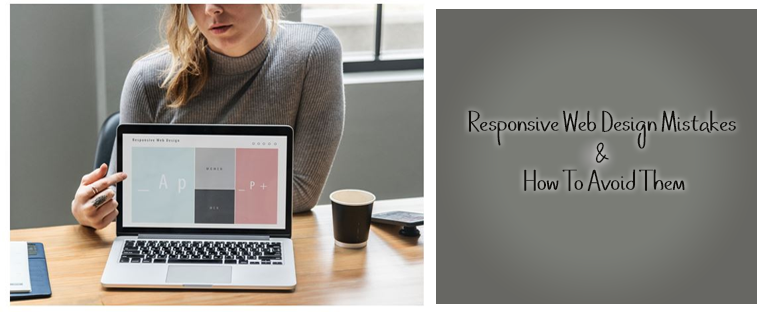Having a responsive website is very important for every company in today’s worlds because people use more their mobile phones to access data than on desktops or laptops. Many web designers, however, find it very difficult to properly execute responsive web design. Let’s address some of the common errors in web design and how we can avoid these mistakes.
Table of Contents
ToggleWhat is Responsive Web Design?
Responsive Web design is the methodology that implies that design and development should respond to the user’s behaviour and environment based on screen size, platform, and orientation.
Responsive Web design is about designing web pages that look good on different screen sizes and viewports.
Your website (and its pages) will adapt and offer the best user experience with responsive website design, whether it’s on their desktop, laptop, tablet, or mobile. But your website needs a responsive design for this to happen. Responsive design aims to have one site, but with different elements reacting differently when viewed on devices of various sizes.
Common Responsive Web Design Mistakes
There are many common responsive web design mistakes. Here we discuss what the common mistakes in responsive web design are:
#1. Loading the website takes too long
Think about it that where do you normally browse the web using your phone? A significant number of people visit mobile websites when in public transit, coffee break at work, or other periods when they have nothing else to do. This means it is very critical that the content loads as quickly as possible due to a lack of time and the use of mobile data. This can be done by optimizing image size and other media, by using a code that is transparent by free of unnecessary elements.
#2. Not using clear images
Many responsive web designers fail to recognize the value of simple and easy images to read. It should not be too large or too little. Because of erroneous image sizing and other related errors, a website can become a caricature of itself. If you’re designing for a major project like an e-commerce website, the mistake will make it a complete mess. Using a proper picture with good exposure and ideal size is always recommendable.
#3. Does not do A / B testing
What works well in one system cannot hold in other devices at all. So it’s recommended to test it on several platforms before taking your website live to discover general UX problems and work them out. It’s common to practice to run low on time and budget for user testing. But checking the website on different platforms will help you at least question your creation choices
#4. Complicated Navigation and Indexing
In responsive web design, developers frequently seem to overlook that they can think from a user’s perspective. Because of the widescreen, a clustered navigation bar with lots of menus and sub-items is easy to explore in the browser. But the user gets confused and irritated in a small screen when they have to scroll through the number of menu items in the navigation window.
#5. Put non-mobile-friendly links onto the page
Significant numbers of visitors are coming from some form of social media. And because of that, you need to be conscious of what kind of solutions you are using on a website. The stream can be disrupted, and if you put a link to your website that leads the reader to a non-mobile-friendly website the flow can be interrupted. If you use external hyperlinks, make sure that the user experience is not messed up by a website that is not mobile-friendly.
Ways to Avoid Responsive Web Design Mistakes
Avoiding the responsive web design mistakes will improve the page load time of the websites and it is better for SEO and better for the search engines, and offers an overall better user experience. Here are some ways to avoid responsive web design mistake are given:
- Stay consistent — Avoid abrupt shifts in places in the color scheme, layout, or sidebar. While variation is possible and encouraged to some extent, when simply changing a page, people shouldn’t feel like they went to another website. Consistency is also essential to your branding.
- Keep it simple — Instead of worrying about what to add to your platform, consider what to delete. Defines each page’s goal and checks for each feature to see if it contributes to achieving that goal.
- Leave lots of space — sufficient whitespace around the design elements is also necessary. Whitespace allows the design to breathe, directs user concentration, and establishes relationships between elements and a hierarchy.
- Use headings — you can also establish topical divisions by using WordPress headings, in addition to breaking your text into smaller sections, so you can render text scannable and give readers a summary without requiring them to read the entire content. Headings are also useful for on-page SEO.
- Divide content — if you’re covering a lot of different topics on your blog, don’t just cram them all in one place. Offer each section it’s own in the form of subpages or archives, group similar pages by topics, and what is not required, remove that.
- Treat performance as part of the design — at the beginning, we said already that web design does not only look but usability too. Visitors generally think that the performance of a website is the most significant quality marker so prepare your output budget accordingly. We have a whole article on how to speed up WordPress, too.
- Be careful with popups — calls to action and other popups can be very successful, but they are also a juggling act between making your readers active and irritating.
Last Words…
Dreamsoft4u Pvt. Ltd. is an experienced Web Application Development Company in India. We hire a brilliant web and mobile app developers who design and develop websites that help companies grow revenue faster and make their website the most effective online selling tool. When you hire us as a custom web application development services, you’re receiving an application that’s designed and developed as per your business requirements. Want to reach us then contact us: (+1)-949-340-7490 | Mail at enquiry@localhost











